|
Program: spa, swimming, tea-drinking, exhibition, meditation
Statement:
“Memorization may seem like a brain-based skill, but it has as much to do with our bodies and our building.”
By Sarah C. Rich
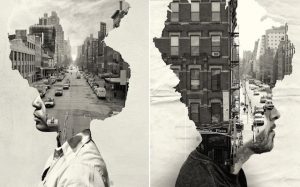
Memory is the store of things learned and retained from our activity or experience, as evidenced by modification of structure or behavior, or by recall and recognition. For the memory of a city, it is always related to space where people meet and events occur.
Public space is used to provide this interaction for people, which also can be called gathering space. Gathering space is like a stage of public lives (or a stage of public memory); it can be a space where friends run into each other and where cultures mix. When we have this kind of space, we can have a strong feeling of city and community. Different space can create different feelings, different feeling related to different memories.
What I want to do for thesis is using architecture language to redefine the unique identity of this kind of interaction space to recall the memory of city. In the city, most of the gathering space is outside, like squares and parks. However, I am not only eager to study outdoor gathering space, but also ready to explore the possibility of building indoor gathering space, as well as the ways to combine the space with the programs in the buildings better.
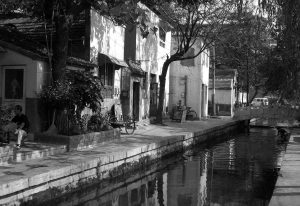
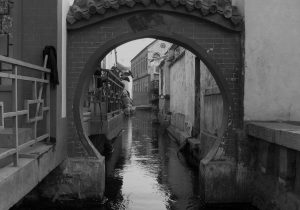
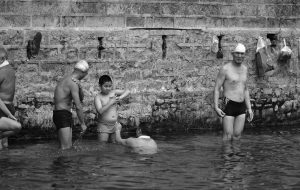
Old images of Qushuiting Street
Jinan is known as the “City of Springs” because of a large number of natural artesian springs. The majority of the springs, many of which have been historically listed under the “72 Famous Springs” are concentrated in the downtown district and flow north to converge in Daming Lake.
Spring plays an important role in the life of the residents in Jinan in the past. When it comes to washing, cooking, swimming and tea-drinking, spring is indispensable.
The area I focus on is called Qushuiting Street. The houses in here are all built along the spring and it flows to every household along the street. Now, this area is not so special any longer. It is facing 4 problems now,
1.Spring water cultural resources need to be protected and developed, the development of spring tourism resources are still in the stage of tourism; the spring water does not actually interact with people.
2.Only old people are interested spring water activities , and the young generation is lacking of awareness of spring culture.
3.The water level is falling, the water quality is getting worse, the environment pollution is becoming more and more serious. To protect the natural environment, the government has banned many spring related activities such as swimming and washing.
4.With regard to previous old areas, they gradually become bleak and deserted. In order to protect these old areas, the government reserves them. Unluckily, it doesn’t take measures and hold activities to attract attention from the outside. Thus, the whole old areas are affected and covered by new areas.
Therefore, I would like to build a spring culture center. I truly hope more residents in Jinan have chances to experience the spring memory. Meanwhile, an experience center where people can get close to spring culture can be built, and the visitors can also experience the culture in Jinan.
In old areas of Jinan, it will be a new kind of building completely different from traditional buildings in Jinan. But with new construction method and new material, you can still find the memory inside. Just like “an activator”, it will be a new culture center in these areas and integrate the activities of the spa, tea-drinking, exhibition, meditation, etc. Trying to find the “spirit of place” can enhance people’s sense of identity and a sense of belonging, and forming space with memory.
Outline of research:
- Study the current situation and main problems in old areas (including surrounding areas’ population composition, transportation, people flow, etc.)
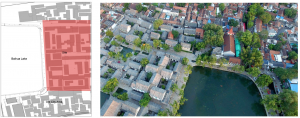
- Investigate the ways of combining the residents’ lifestyles with spring. And then taking current lifestyles into consideration, determine the programs in the building and also build a whole walking system in the old city area.
- Analyze the cases about public space, and consider how to organize population flow and how to integrate the gathering space with buildings.
- Think about how to use a new architectural language to build a culture center in old areas(the new architectural language may contain new technologies, shapes, structures, construction methods, materials, etc.)
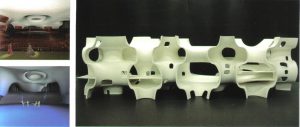 National Taichung Theater National Taichung Theater
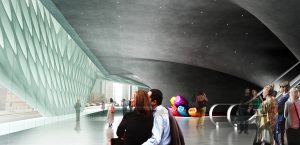 The Broad Museum The Broad Museum
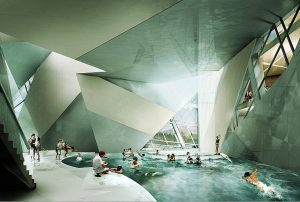 Westside Shopping and Leisure Centre Westside Shopping and Leisure Centre
- Determine the building’s scale and focus on the structure of space and the formation of the atmosphere (memory).
Reference:
1.Steven Holl, Anchoring, Princeton Architectural Press, New York, 1989
2.Peter Zumthor, Atmosphere, Birkhäuser Architecture; 5th Printing. Edition (June 1, 2006)
3.Kevin Lynch, The Image of the City, The MIT Press; 1St Edition edition,1960
4. Thom Mayne, Combinatory Urbanism A Realignment of Complex Behavior and Collective Form, Stray Dog Cafe, 2011
|